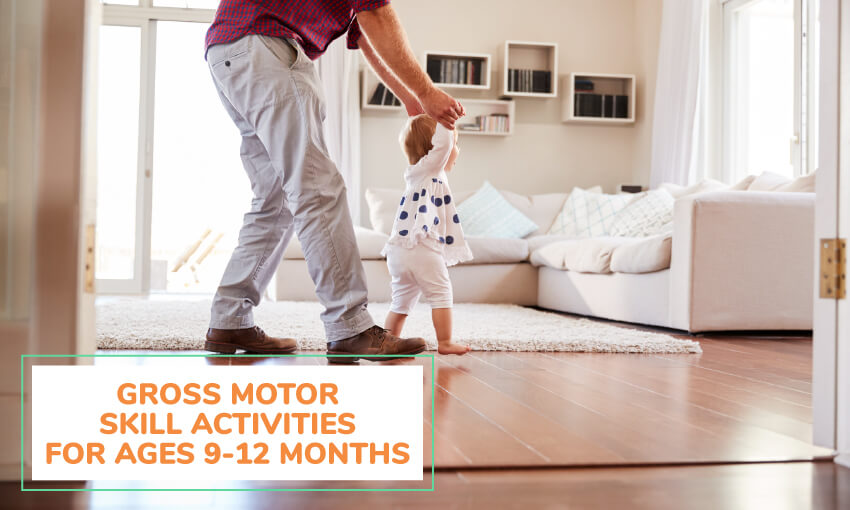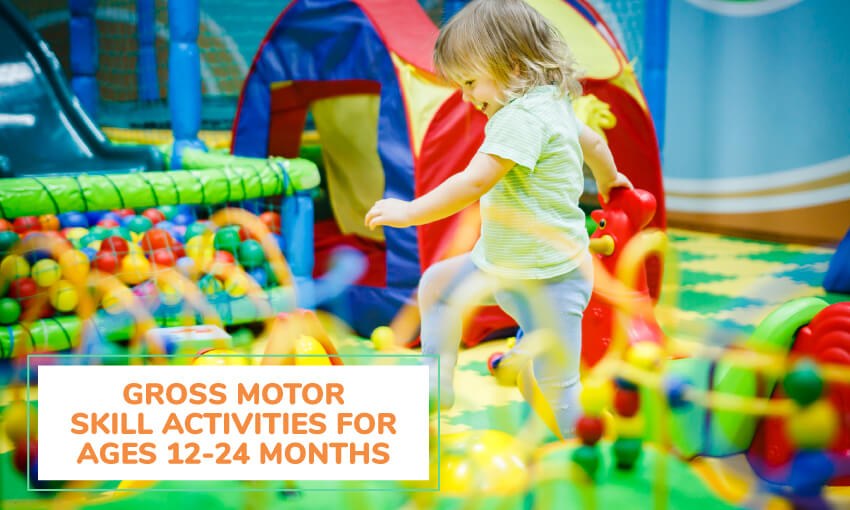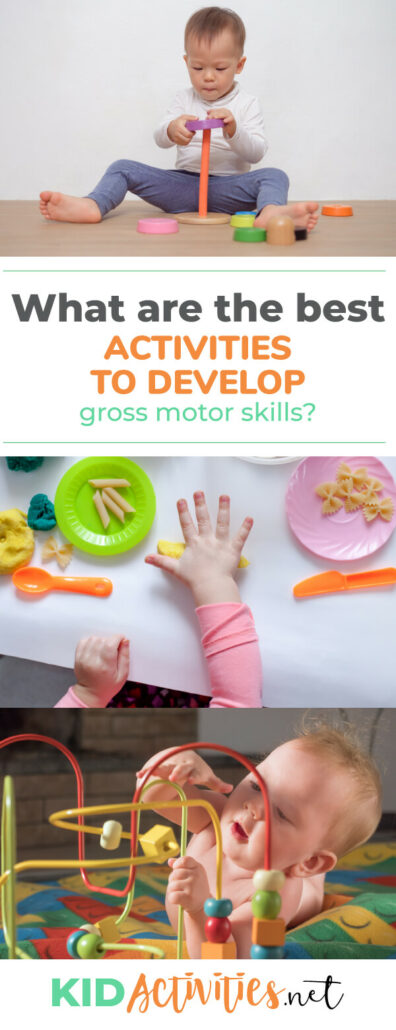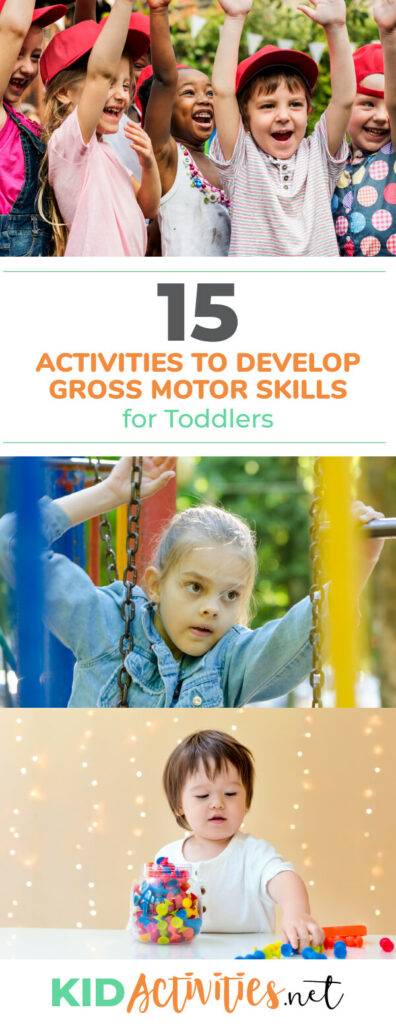Activities to Develop Gross Motor Skills
Your baby begins to go through the different stages of development growth from the day of conception.
The first thing your little one will develop is the nervous system. This is the time the brain, spinal cord, and nerves all begin to grow and connect.
The next part of development is the baby’s little heart, followed by the face, limbs, and then the sexual organs. By the end of the tenth week of your pregnancy, your baby will have developed muscles and movement.
All these are reasons why it’s important for you to take care of yourself during your pregnancy; a healthy diet, prenatal vitamins, and doctor visits are just some of the things you can do to help with your baby’s growth and development.
As silly as you might feel, you should read to your baby while you’re pregnant. You might not realize it, but your baby begins a bond with you and becomes familiar with your voice before you meet face to face.
All this is just the beginning of your baby’s growth and development. Once your baby arrives, he/she will depend on you for everything; clean clothes, fresh diapers, love, and learning.
From birth to 3-years of age a child’s brain continues to grow and build numerous connections and pathways, so, for this reason, it’s important to establish a good routine that involves repetition and activities for the growth of your baby’s gross motor skills development.
Gross Motor Skills
Gross motor skills are the development of the greater, stronger muscles in your baby’s body.
You have seen a newborn’s wobbly head, relying on you for support. That’s because when babies are born they have yet to grow into all their muscles. It takes time for them to get stronger, and that’s why the baby goes through different stages of growth development.
The first achievement they will make with the muscle growth will be their head. You will notice that after the first month of the baby’s life, he/she will gain stronger muscles in the neck, eventually able to control his/her head alone without your help.
Throughout the next few months of their life, they will begin to move more freely, exercising their arms and legs. Eventually, they will begin to roll just a bit onto their side, gradually increasing their strength until they have accomplished rolling onto their tummy. At that time though, they will probably rely on you to roll them back because it was a lot of work just getting that far and more than likely they won’t have enough strength to go back to where they started.
Once your baby has achieved rolling from front to back freely, the next stage will be sitting up and they will need your help again during this process. For a while, they will depend on you to prop them up against you, a pillow, or another place that will completely support them. During this time, you should notice how observant your baby is. You might only think they have no idea what’s going on around them, but don’t let that cute little face fool you, your baby is smarter than you might think at this stage.
By the time your baby reaches 9-months old, they should have all those struggles conquered and they should be able to:
- Sit up without support
- Completely crawl on hands and knees
- Start walking with your help
- Pull themselves up to stand at furniture
- Imitate your actions
Now is the time you will need to start planning some activities that will help them to exercise and develop their brain further.
There are many fun activities that you can do with your little one; some activities you can create by using things from around the house, and there are some cool things you can buy as well.
No matter what activities you create for your baby’s playtime, it’s important to remember that they will once again rely on you for teaching them and to play with them. This is a great time for their little brains to learn about imagination, and the bonding time you share is more valuable than anything else you will ever experience in your lifetime.
The following is a list of 15 activities to develop gross motor skills for your toddlers. The activities are broken down easily by age groups and the first three activities in each group are ones that you can enjoy using things from around the house. The last two activities in each group will give you the ideas of things you can buy to incorporate into your imagination time.
Make sure you check out our sensory play activities as well.
Gross Motor Skill Activities for Ages 9-12 months
1. The Diaper Changing Workout
By the time your baby gets to this age, diaper changing becomes a workout. You probably experience flipping and flopping like your baby is suddenly a fish out of the water. You might even find your little one trying to help, and we all know how messy that can be, so this would be a good time to turn the workout into a fun exercise.
When your baby starts flipping and flopping you should start singing. Once you draw their attention, they will stop and look at you. When they stop moving, you stop singing. When they start flopping again, you start singing again. You will be surprised at how fast your baby will figure out the power of control. They will have fun controlling you and before you know it, the diaper will be new, and they won’t even realize you ever changed it.
When you’re finished, give them some kisses and positive assurance. If you’re not sure what songs to sing at this age, try singing “The Wheels on the Bus,” they love that one. You can also get creative and turn nursery rhymes into songs. Even if you don’t know all the words, that’s okay they won’t care, just make up some words along the way.
2. Cardboard Box Time
How many gifts have your baby received but chose to play with the box instead of the toy? It’s amazing how simple little things like a box can make a baby happy. You can create all kinds of activities with a box. Turn it upside down and use it as a drum, show the baby how to hit it and watch as they mimic your action. Turn the box into a house for toys. Set it up on its side and show your baby how to stack the toys inside. Fill it with stuffed animals and then listen to the giggles as you pour them out. Be creative and watch your baby’s eye light up with joy.
3. Container Play:
Incorporate different size containers into play time and make them into building blocks. Stack them up and knock them down. Your baby might not get down the concept of stacking the containers, but they will love knocking them down. Use this time to fill the containers with smaller toys and have fun dumping them out again, and although your baby might not understand yet, this would be a good time to count the toys or teach them how to separate them into categories by color, animal, or whatever the toys are.
4. Tunnel Play
Consider purchasing this cool tunnel to incorporate into playtime. It’s designed for children who are learning to crawl. It’s colorful and decorated with water animals for recognition, and the mesh windows will not scare them as they crawl through the tunnel. It’s easy to set up and it won’t take up a lot of space. Not only is this a tunnel, but you have the option to purchase an additional tent that it connects to so that the baby can grow with this toy.
You can crawl along the outside of the tunnel while encouraging your baby to race you to the end. You can even put one of their favorite toys at the end of the tunnel to give them the incentive to crawl. When they get to the end of the tunnel, meet them with a kiss. This toy gives them a lot of exercises and will strengthen their muscles in their legs and arms.
5. Imagination Time with Bath Toys
Most babies love bath time, but by this age, they can get bored really fast. You can make it fun for them by adding some fun bath toys. Choose this fun set of bath toys and create all kinds of fun with the six stacking animal cups. They have drains in them, so you can show your baby how to make it “rain” in the bathtub. There are a plastic fish and pig that can float alongside the boat and submarine through the “rain.” You can make it “rain” harder with the fun watering can that comes with this set of bath toys.
When you’re finished, teach your baby how to put the toys away in the mesh storage bag. Add some rubber ducks and let them float and quack through the “rain.” If your baby doesn’t like wash time, include a waterproof doll to the tub and wash the doll first. Remember that your baby will be imitating your moves, so make it simple for them to copy you. You can teach your baby a lot about imagination in the bathtub while making the whole experience fun.
Gross Motor Skill Activities for Ages 12-24 months
1. The Rowing Game
At this stage of your toddler’s life, they will enjoy music more than before, they might even try and sing songs with you. This is a good time to sit on the floor across from each other. Hold hands and begin to rock like a boat, this will be easy because your baby is probably going through a stage where they love to rock. Sing the song “Row, Row, Row Your Boat” and after each verse sing the next a bit faster while speeding up the rocking. Your little one will enjoy this time with you and will probably ask you to do it again.
2. Laundry Basket Ball
Maybe your toddler already likes to climb in and out of your laundry basket, so why not create a fun sports activity you can play together? Set up the basket and gather plastic balls or small pillows. Anything soft will work for this game. Stand with your little munchkin or get on your knees to be on the same level, and take turns tossing the “balls” into the basket. This will help to build your toddler’s upper body strength, eye-hand coordination, and they will begin to learn how to take turns. When they make a basket, be sure to clap and cheer them on so they completely understand the concept of the game.
3. Laundry Basket Wagon
This is another fun laundry basket activity. Make a handle on the basket by tying a string to one end. Gather stuffed animals and baby dolls and set them up inside the basket. Show your toddler how to pull the animals and babies through the house like a wagon.
4. Musical Instrument Fun
Now that your toddler is learning more about music, one of the best activities you can incorporate into play is an array of musical instruments. Consider this colorful set of percussion instruments for the development of your toddler’s gross motor skills.
This selection of instruments will teach your little one how to shake the bells using their arms, and the sticks can be helpful in building arm strength when they glide them across the xylophone and bang them on the tambourine.
There are enough instruments in this set that you could give one to all your children and form a family band. Be sure to do plenty of dancing and clapping while enjoying the musical fun with this activity..
5. Bowling Fun
This is the perfect stage to roll a ball back and forth to your precious babe, so why not teach them how to bowl while you’re at it? By now you’ve established that your little one loves bright colors and animal recognition, that’s why this is the perfect bowling set to consider. It comes with six colorful animals (the pins) made of soft plastic, so you won’t have to worry about them getting hurt and the bright colorful ball provides finger slots for your toddler to easily grip the ball. You could easily play this game in the house or set it up in the driveway to enjoy the fresh air while having fun.
Gross Motor Skill Activities for Ages 24-36 months
1. Little Birdie Copy Cat
This game gives your toddler a chance to mimic your moves while playing pretend. You should start by being the leader; spread your arms out pretending to be a bird. “Fly” around the room chirping and making different moves while your little one follows you copying you. Let them be the leader next and you will do what they do. This game will cause them to giggle while they exercise their body and brain. This is another activity that will also help with teaching them to take turns.
2. Make the Goal
Using a ball and a cardboard box you can create the scene of a successful soccer game. Turn the box on its side to make a goal. Take turns kicking the ball into the goal. This is another game that can be set up indoors or out and can be enjoyed by the whole family. This activity will keep your toddler moving, it will help with coordination, and it will teach them about taking turns. If you have more children, you can divide them up and use this as a team-building exercise.
3. Bubbles, Bubbles, and More Bubbles
Every child enjoys spending time with a bottle of bubbles, so why not make this a child development activity? Blow some bubbles and work together at catching them. Blow some toward the ground and show your toddler how to step on them. Allow your little one to have a turn blowing the bubbles toward the ground for you to step on. You will probably want to save this for a nice afternoon outdoors.
4. Playground Activities
Spending time on the playground is not only important for the development of your child’s gross motor skills, but it’s also a lot of fun. When your little munchkin wants to swing, show them how to kick their legs back and forth to teach them how to make the swing go by themselves. Climbing on a jungle gym and sliding down a slide are highlights of a playground visit too.
If it’s not possible for you to visit a playground often, the best thing to do is make a playground in your backyard. With this Little Tikes 2-in-1 Castle climber, your children can climb, slide, and jump as often as they want. It provides a ladder for them to climb to the top and a slide to get back down. There are two platforms for them to stand and jump on, and a plank to climb and walk on. With the castle design, they will not only get the exercise they need, but they can also play imagination games to help their brains grow strong.
5. Trampoline Fun
On a cold and rainy day, your little one might be full of energy with no way to burn it off. With an indoor trampoline, that problem could be solved. The Little Tikes 3-foot trampoline is a perfect size and the safest trampoline for this age group. The trampoline provides a safety bar to help your toddler keep a steady balance. It’s designed for use by only one child at a time up to 6 years old, so this is one they can keep for a long time. Since it’s for indoor use, you might want to incorporate some music for them to jump with or turn on a video packed with age-appropriate exercises for them to do on the trampoline. This is the perfect way to keep them active and safe while playing indoors.






